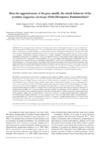Use este identificador para citar ou linkar para este item:
http://www.alice.cnptia.embrapa.br/alice/handle/doc/928966Registro completo de metadados
| Campo DC | Valor | Idioma |
|---|---|---|
| dc.contributor.author | SILVA, R. B. da | pt_BR |
| dc.contributor.author | CORREA, A. S. | pt_BR |
| dc.contributor.author | LUCIA, T. M. C. D. | pt_BR |
| dc.contributor.author | PEREIRA, A. I. A. | pt_BR |
| dc.contributor.author | CRUZ, I. | pt_BR |
| dc.contributor.author | ZANUNCIO, J. C. | pt_BR |
| dc.date.accessioned | 2012-07-24T11:11:11Z | pt_BR |
| dc.date.available | 2012-07-24T11:11:11Z | pt_BR |
| dc.date.created | 2012-07-24 | pt_BR |
| dc.date.issued | 2012 | pt_BR |
| dc.identifier.citation | Revista Brasileira de Entomologia, São Paulo, v. 56, n. 2, p. 244-248, jun. 2012. | pt_BR |
| dc.identifier.uri | http://www.alice.cnptia.embrapa.br/alice/handle/doc/928966 | pt_BR |
| dc.description | Does the aggressiveness of the prey modify the attack behavior of the predator Supputius cincticeps (Stål) (Hemiptera, Pentatomidae)? The stink bug Supputius cincticeps (Stål) (Hemiptera, Pentatomidae) is a predator found in several Brazilian regions, which possesses desirable attributes as a natural control agent and in biological control programs. The aim of this study was to test if the attack behavior and predation success of S. cincticeps were affected by prey species. Larvae of Tenebrio molitor (L.) (Coleoptera, Tenebrionidae), Spodoptera frugiperda (J. E. Smith) (Lepidoptera, Noctuidae), and Thyrinteina arnobia (Stoll) (Lepidoptera, Geometridae) were offered to S. cincticeps in laboratory bioassays where predatory attack and prey defensive behaviors were observed for 2-hour periods. The attack behavior of S. cincticeps changed with the prey species offered. More than 25% of T. molitor and S. frugiperda larvae were immediately attacked, but T. arnobia was not immediately attacked by S. cincticeps. Successful attack (i.e., successful insertion of the predator stylets into the prey) depends on the region of the body attacked, with a greater proportion of successful attacks in the anterior than in the median or posterior regions. Larvae of T. arnobia and S. frugiperda displayed a sequence of abrupt head and body movements in response to S. cincticeps attack. Attempts of predation were more successful on T. molitor and S. frugiperda than on T. arnobia. Information about the differential attack behavior of S. cincticeps on different prey species is important for designing successful biological control programs using this hemipteran predator. | pt_BR |
| dc.language.iso | eng | eng |
| dc.rights | openAccess | eng |
| dc.subject | Ethogram of predation | pt_BR |
| dc.subject | Fall armyworm | pt_BR |
| dc.subject | Stink bug predator | pt_BR |
| dc.title | Does the aggressiveness of the prey modify the attack behavior of the predator Supputius cincticeps (Stål) (Hemiptera, Pentatomidae)? | pt_BR |
| dc.type | Artigo de periódico | pt_BR |
| dc.date.updated | 2017-09-28T11:11:11Z | pt_BR |
| dc.subject.thesagro | Controle biológico | pt_BR |
| dc.subject.thesagro | Praga de planta | pt_BR |
| dc.subject.thesagro | Lagarta | pt_BR |
| dc.subject.thesagro | Percevejo | pt_BR |
| dc.subject.nalthesaurus | biological control | pt_BR |
| riaa.ainfo.id | 928966 | pt_BR |
| riaa.ainfo.lastupdate | 2017-09-28 -03:00:00 | pt_BR |
| dc.identifier.doi | 10.1590/S0085-56262012005000031 | pt_BR |
| dc.contributor.institution | RAFAEL BRAGA DA SILVA; ALBERTO SOARES CORREA; TEREZINHA MARIA CASTRO DELLA LUCIA, UFV; ALEXANDRE IGOR AZEVEDO PEREIRA; IVAN CRUZ, CNPMS; JOSE COLA ZANUNCIO, UFV. | pt_BR |
| Aparece nas coleções: | Artigo em periódico indexado (CNPMS)  | |
Arquivos associados a este item:
| Arquivo | Descrição | Tamanho | Formato | |
|---|---|---|---|---|
| Doesaggressiveness.pdf | 485,56 kB | Adobe PDF |  Visualizar/Abrir |









